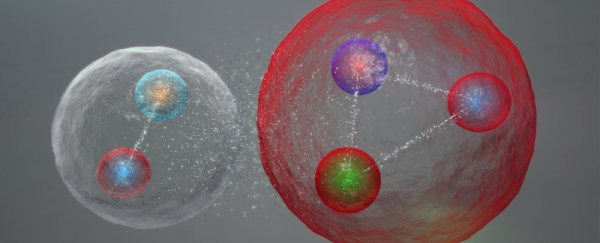Just months after switching the Large Hadron Collider (LHC) back on at record-breaking energy levels, researchers at CERN in Switzerland have reported the discovery of a whole new class of subatomic particles, called pentaquarks. Not only has it solved a 50-year mystery surrounding the elusive particle, but it's providing new insight into the ways in which matter can be formed.
Quarks are the building blocks that make up composite subatomic particles, and these particles are classified depending on how many quarks they're comprised of. For example, both protons and neutrons are made up of three quarks, and are classed as baryons. But this is the first time researchers have shown that a five-quark arrangement - or pentaquark- exists.
"The pentaquark is not just any new particle," CERN spokesperson Guy Wilkinson told the press. "It represents a way to aggregate quarks, namely the fundamental constituents of ordinary protons and neutrons, in a pattern that has never been observed before in over 50 years of experimental searches."
Scientists have been looking for pentaquarks since 1964, when American physicist Murray Gell-Mann first proposed the quark model. Although his work was on baryons, the model allowed the existence of other quark composite states, such as a hypothetical pentaquark, which would be comprised of four quarks and an antiquark. But no one has been able to find evidence of such a state existing until now, thanks to the powerful LHCb experiment.
Physicists noticed the pentaquarks while examining the decay of a baryon known as Lamda b into three other known particles. For the first time, they also observed a transition state, in which they identified two never-before-seen particles: Pc(4450)+ and Pc(4380)+.
After studying the mass of these particles, the team concluded that they could only be explained by being in pentquark states. "More precisely, the states must be formed of two up quarks, one down quark, one charm quark, and one anti-charm quark," said LHCb physicist Tomasz Skwarnicki.
They were able to finally confirm this, thanks to the huge amount of data provided by the LHCb. "It's as if the previous searches were looking for silhouettes in the dark, whereas LHCb conducted the search with the lights on, and from all angles," the CERN release explains.
The results have been submitted to the journal Physical Review Letters, and are published online in arXiv, and the team is now studying the new pentaquarks further to try to work out exactly how the five quarks are bound together.
Working this out will help physicists understand more about the structure of all particles, as well as provide insight into how quarks interact. "Studying [the pentaquarks] properties may allow us to understand better how ordinary matter, the protons and neutrons from which we're all made, is constituted," said Wilkinson.
Find out more about quarks in this Physics Girl video:

